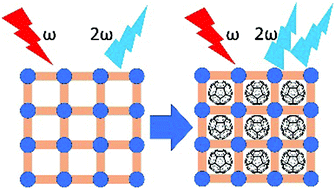Host and guest joining forces: a holistic approach for metal–organic frameworks in nonlinear optics†
Abstract
Metal–organic frameworks (MOFs) are interesting candidates for applications in nonlinear optics (NLO). However, current design strategies for MOFs in NLO are typically limited to either engineering the MOF itself or using the MOF to align NLO-active molecules within its pores. But more design factors can be considered when engineering MOFs and choosing guest molecules. The NLO emission of the host and guests can be combined instead of using only either one of the two. The interaction between the host and guest can be a source for further improvement by changing the symmetry, dipole moment, bond lengths, charge distribution, etc. Additionally, unstable NLO molecules can potentially be stabilized by accommodation in the MOF. Here, we demonstrate a new strategy for MOFs by combining MOF-177 as a host and Li@C60 as a guest for NLO, meaning that both the MOF itself as well as the guest molecules are emitting NLO signals, as well as further increasing the emission using their interaction elongating bonds within the MOF, thus fully using the MOF's potential for second harmonic generation. Using this approach, the overall emission can be boosted by 40% compared to MOF-177 alone. Furthermore, the accommodation into MOF-177 stabilizes Li@C60 that is normally unstable under ambient conditions without a counterion.



 Please wait while we load your content...
Please wait while we load your content...